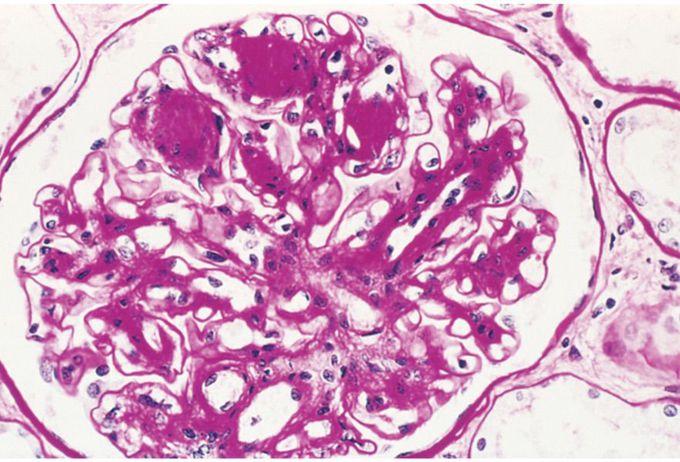
Renal disease
A 58-year-old man is found to have mild hypertension. Laboratory findings show a serum creatinine level of 2.2 mg/dL and urea nitrogen level of 25 mg/dL. Microalbuminuria is present, with excretion of 250 mg/day of albumin. Two years later, he remains hypertensive and has a serum creatinine level of 3.8 mg/dL, urea nitrogen level of 38 mg/dL, and 24-hour urine protein level of 2.8 g. A renal biopsy is done; the light microscopic appearance of a PAS-stained specimen is shown in the figure. Blood/serum test for which of the following is most likely to be abnormal in this patient? A. Anti–glomerular basement membrane antibody B. Antinuclear antibody C. Anti–neutrophil cytoplasmic autoantibody D. Anti–streptolysin O E. C3 nephritic factor F. Hemoglobin A1c G. Hepatitis B surface antigen —�—�—�—�—�—�— . Glycated hemoglobin (hemoglobin A1c, HbA1c, A1C, or Hb1c; sometimes also referred to as being Hb1c or HGBA1C) is a form of hemoglobin that is measured primarily to identify the three-month average plasma glucose concentration. In diabetes mellitus, higher amounts of glycated hemoglobin, indicating poorer control of blood glucose levels, have been associated with cardiovascular disease, nephropathy, neuropathy, and retinopathy. The figure shows nodular and diffuse glomerulosclerosis that often occur in patients with long-standing diabetes mellitus, which is often complicated by urinary tract infections. Infections with bacterial organisms also occur more frequently in patients with diabetes mellitus who have an elevated Hgb A1c. Deposits of IgG and C3 in the glomerular basement membrane occur with forms of glomerulonephritis (GN) caused by immune complex deposition, including lupus nephritis and membranous nephropathy. The only abnormality observed in minimal change disease is effacement of podocyte foot processes, but this change is not specific for minimal change disease and may be seen in other disorders that produce proteinuria. Crescentic GN is not typically seen in diabetes mellitus. IgA deposition in the mesangium occurs in IgA nephropathy (Berger disease). A necrotizing granulomatous vasculitis can be present in the kidneys of patients having granulomatosis with polyangiitis (ANCA-associated vasculitis).
